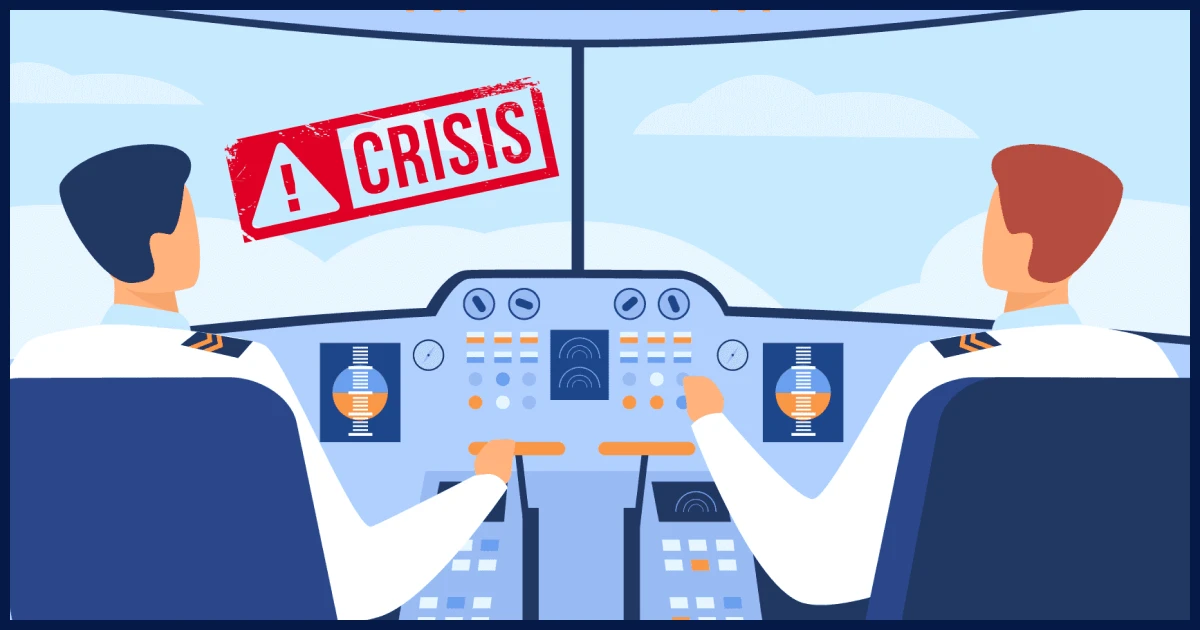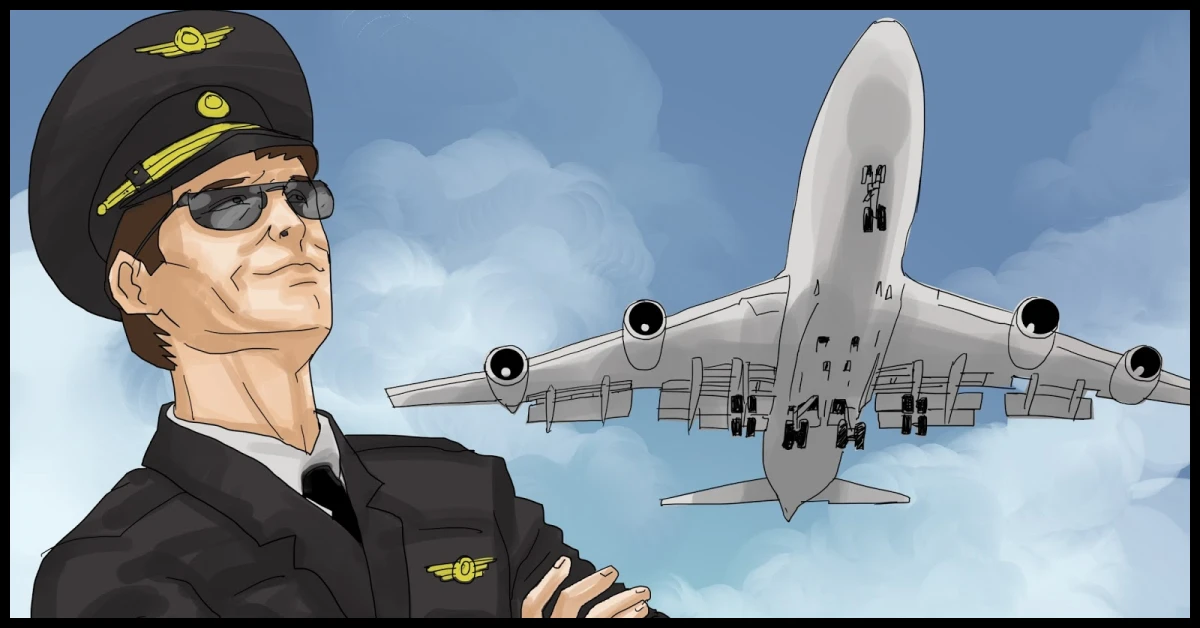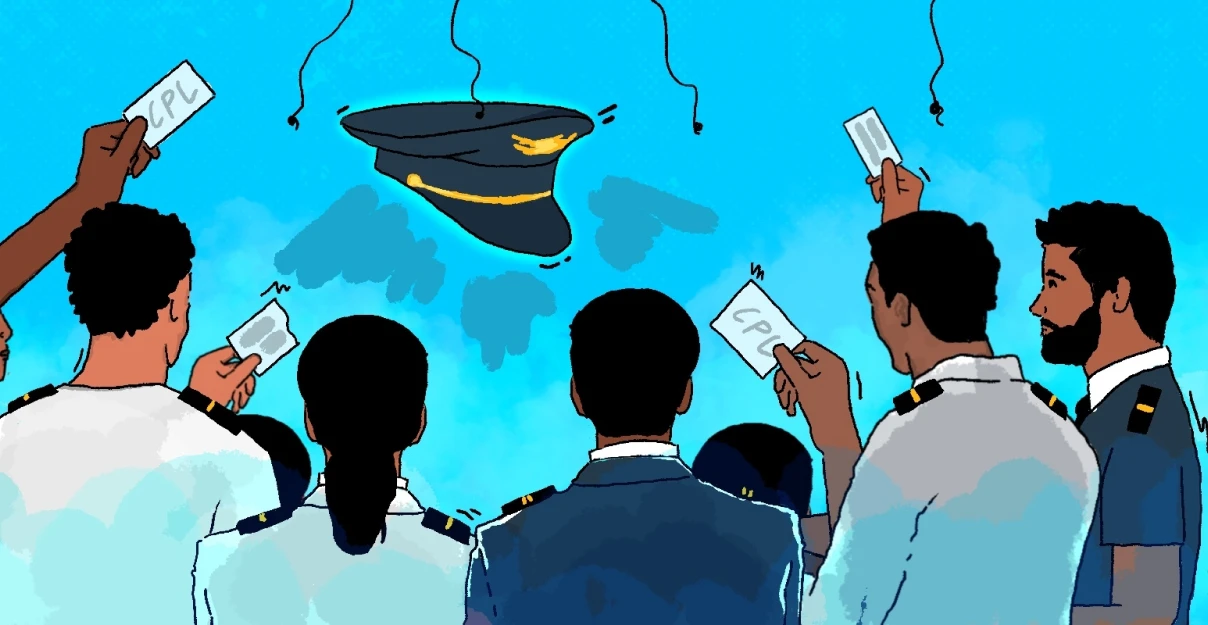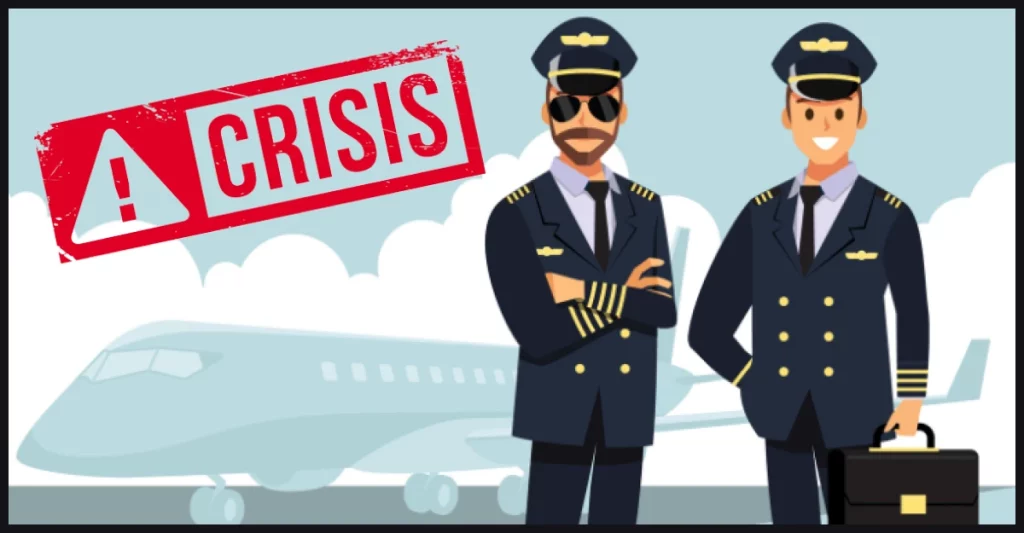On 1st & 2nd April 2024, Vistara Airlines had to cut nearly 50-60 flights to deal with the shortage of pilots and crew. That was an absolute head-scratcher for passengers! This incident brought the Pilot crisis in India into the limelight…

Now, aviation companies are using large-body aircraft such as Boeing 787-9 Dreamliner and A321 Neo for domestic routes so that they can accommodate a higher number of passengers in a single go… Why are we falling short of pilots? You may wonder.
In this write-up, we will uncover the Indian aviation issues including the pilot crisis in detail.
Stay tuned!
Story so Far: Shortage of Pilots in India

You see, the shortage of pilots is more than just a hiccup, it’s a puzzle waiting to be solved. The President of the Airline Pilots’ Association of India, already predicted the shortfall of pilots ranging from 20% to 30% for airlines!
Now, let’s talk numbers. According to experts, India’s commercial airlines are on track to double their fleet size by fiscal 2029-30. That’s a whopping 1,400 aircraft! But here’s the catch- to fly these airplanes, we need at least 10,900 extra pilots by 2030. That’s like finding 1,600 new pilots every year. Last year, the regulatory authority already issued 1,272 licenses for commercial pilots.
And amidst all this, there’s an influx of activity. Leading airlines like IndiGo and Air India are ordering planes left and right, while Tata group-owned Air India is gearing up for a jaw-dropping fleet expansion, bringing in one aircraft per week for an entire year!
But it’s not all smooth flying. Safety and pilot well-being are crucial as well. So, airlines are reducing pilot duty hours to ensure everyone stays safe and sound.
But here’s the twist… Even with these adjustments, airlines still need 20% more pilots to keep operations running smoothly!
And just when you thought things couldn’t get more intense, there’s another plot twist. In a total fleet of 789 aircraft, around 150 to 200, are currently grounded due to technical issues.
But fear not, because despite these challenges, the future looks bright. With orders pouring in for over 1,100 new aircraft, the demand for pilots is set to skyrocket!
The following sections describe the reasons for the Pilot crisis in India.
Shortage of Flying Institutes

The aviation world is buzzing with talk about the shortage of flying institutes. Experts are stressing the urgent need to establish more of these training grounds, along with exploring alternative solutions like hiring foreign pilots. Surprisingly, there are fewer than 100 foreign nationals flying planes in India, according to DGCA data.
But here’s the kicker- keeping talent in the country is a whole different game, and it all boils down to offering the right incentives, like tax breaks.
Now, let’s dive into the numbers.
As of November 2022, India boasts 34 approved Flying Training Organizations (FTOs) operating across 52 bases, as per the DGCA. These FTOs are managed by various entities, including the central and state governments, along with the private sector. Plus, there are around six aviation training centers equipped with 40 simulators.
And guess what?
Private flying academies are also jumping on the pitch, securing licenses, while airlines are ramping up their training programs.
But wait, the grass is now always green. Despite the optimistic figures and plans, the aviation industry is facing some hefty challenges, as pointed out by seasoned crew members and cadet pilots.
Captain Sam Thomas, a veteran with heaps of flying experience and president of the Airline Pilots’ Association of India, points fingers at the difficulty of operating flying training centers. He blames outdated regulations enforced by corrupt officials for the current pilot shortage.
And let’s not forget about the medical standards, which, overseen by Indian Air Force (IAF) doctors, often lead to civil pilots being grounded. It’s like navigating through stormy skies in search of smoother air.
Navigating Challenges faced by Cadet Pilots
Cadet pilots are up against quite a few hurdles in their journey to take flight. Let’s look at them one by one-
| Challenges | Description |
| High Training Costs | First off, the steep price tag of pilot training, averaging around Rs.1 crore, is a major roadblock. And to make matters worse, flying clubs can demand fee hikes without any prior notice, thanks to a lack of clear regulations from the DGCA. |
| Rising Additional Fees | Airlines aren’t making things any easier either. They’ve started tacking on extra charges for type rating, which can skyrocket a course that initially costs Rs.18 lakh to nearly Rs. 1 crore. |
| Uncertain Job Prospects | With the recent changes, even the emergency exit strategy isn’t as clear-cut. When airlines shut down, the more seasoned pilots often get first preferences, leaving cadets with low flying hours in a stressful position. |
| Training Discrepancies | Training abroad versus training in India? It’s like comparing apples to oranges. Cadets overseas enjoy more freedom in planning their flights, while their counterparts in India face stricter rules and limitations. |
| Infrastructure Challenges | Most training bases in India are located at uncontrolled aerodromes, lacking proper navigation aids. This means cadet pilots have to rely on crowded controlled aerodromes for their instrument training, adding another layer of complexity. |
| Strain on Relationships | Balancing the instructor-student relationship on the ground is no walk in the park either. Exams often feel rushed and unprepared, but thankfully, the DGCA’s e-governance platform is bringing some much-needed order to the chaos. |
| Shortage of Captains | To top it all off, there’s a severe shortage of captains in the industry. While there may be plenty of commercial pilot license-holders, grooming them into co-pilots requires meticulous planning. |
| Safety Compromises | Unfortunately, safety is taking a backseat as airlines cut corners on training protocols. The current civil aviation requirements are feeling the strain of increased flight operations, leading to gaps in training programs and a shortage of qualified trainers. |
So, as you can see, the path to becoming a pilot in India isn’t smooth sailing.
Pilot Shortage Impacts Training Operations

The shortage of pilots isn’t just causing headaches for airlines—it’s also throwing a wrench into training operations. Here’s how-
- Lowering Requirements: Efforts are underway to lower the bar for promoting co-pilots to commanders. While this might seem like a quick fix for the shortage, it comes with its own set of risks. With less experienced pilots on the flights, safety standards could take a nosedive.
- Training Gaps: A whopping 50% of India’s 10,000 pilots lack training in CAT-III operations. That’s like trying to drive in the dark without headlights! Without proper training, pilots could struggle to navigate through challenging weather conditions, putting both passengers and crew at risk.
- Innovative Solutions: But fear not, because there’s light at the end of the runway. Airlines can explore fog-limited schedules to tackle weather-related delays head-on. By strategically planning their routes, they can protect vital sections of their network from getting bogged down by foggy conditions.
So, while the pilot shortage may be causing turbulence in the industry, there are ways to navigate through the storm. With innovative solutions and a commitment to safety, we can keep the skies clear and the flights on track.
Costly Recruitment Process
Becoming a pilot in India is not a cakewalk anymore—it’s a lengthy and pricey journey. Let’s see how-
- High Educational Barriers: The educational requirements for aspiring pilots in India are sky-high compared to other places. Despite jumping through hoops to meet these standards, the quality of instructors and aircraft often leaves much to be desired. It’s like aiming for the stars but getting stuck in the clouds.
- Training Institute Woes: And let’s talk about training institutes. They’re struggling with outdated equipment and, sadly, are sometimes plagued by corruption. But fear not, because big players like IndiGo Airlines, Air India, and Akasa Air are stepping up their game to improve training facilities. It’s like giving the old training ground a fresh coat of paint!
- Market Comparison: Now, here’s where things get interesting. Despite being the third-largest domestic aviation market, India’s aviation scene still feels relatively small in comparison. Just think about it- the fleet size of American Airlines alone outstrips all airlines in India combined. And don’t even get us started on China—they’ve got about six times more pilots than India! It’s like David facing off against Goliath in the world of aviation.
So, while the recruitment process may be costly and complex, with the right improvements and innovations, India’s aviation industry can soar to new heights. It’s all about navigating through the challenges and aiming for the skies!
Potential Solutions to Tackle the Pilot Crisis in India
Now, let’s briefly look at the solutions that can help to solve the ongoing Indian aviation challenges regarding pilot shortages-
| Solutions | Description |
| Lowering Educational Requirements | Reduce the stringent educational criteria for pilot training to make it more accessible to a wider pool of candidates. |
| Enhancing Training Facilities | Invest in upgrading training institutes with modern equipment and facilities to improve the quality of pilot training. Develop fast-track training programs to expedite the process of qualifying as a pilot without compromising quality |
| Implementing Incentive Programs | Offer financial incentives or scholarships to aspiring pilots to alleviate the financial burden of training costs. |
| Strengthening Regulatory Oversight | Tighten regulations to ensure transparency and accountability in the pilot training process, reducing corruption. |
| Expanding Aviation Education Programs in Schools | Introduce aviation education programs in schools to spark interest in aviation careers at a young age. |
| Collaborating with Airlines and Aviation Organizations | Forge partnerships between airlines, training institutes, and aviation organizations to streamline pilot training. |
| Increasing Recruitment of Foreign Pilots | Recruit more foreign pilots to temporarily fill the pilot gap while investing in long-term solutions for local training. |
| Promoting Gender Diversity in Aviation | Encourage more women to pursue careers in aviation through targeted recruitment and support programs |
| Enhancing Pilot Retention Strategies | Develop strategies to improve pilot retention rates through better working conditions, career advancement, and benefits |
By using these new and smart ideas, we can deal with the problems caused by the lack of pilots in India’s aviation industry and make sure things get better in the future.
Wrap-Up
In a nutshell, the pilot shortage in India exposes major issues in the aviation sector. To fix this, we need to make it easier for people to become pilots, improve training facilities, and encourage more diversity. Working together, airlines, schools, and regulators can help solve this problem.
By doing this, we can make sure there are enough pilots for future flights, keeping the aviation industry strong and safe in India!


Becoming a Pilot in India is too expensive! Lemme give a quick sol. Just qualify NDA, become an IAF pilot, get trained for free, work in defence for 15 years with handsome package, and then join commercial airlines that pay huge bucks!